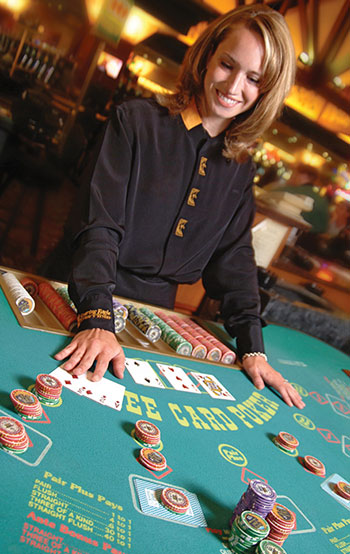WINNING AT THREE CARD POKER
The story behind the game, and smart strategies for beating the house
By Basil Nestor
 Three Card Poker is a game with a twist, as well as an interesting history. The casino version was first created by Derek Webb and purchased and licensed by ShuffleMaster (the company that revolutionized the world of automatic shufflers), and was introduced in 1994. But even though the contest has “poker” in its name, it’s actually based on a very old British game called “brag” that has roots going back to the sixteenth century.
Three Card Poker is a game with a twist, as well as an interesting history. The casino version was first created by Derek Webb and purchased and licensed by ShuffleMaster (the company that revolutionized the world of automatic shufflers), and was introduced in 1994. But even though the contest has “poker” in its name, it’s actually based on a very old British game called “brag” that has roots going back to the sixteenth century.
Brag is an ancestor of poker. So when you play Three Card Poker, you’re playing a latter-day version of a contest that was a favorite of English royalty, pith helmet-wearing, globe-hopping explorers, and famous gamesters such as Edmond Hoyle. The three-card concept and unique hand rankings have survived from the time of King Henry VIII all the way to you.
What Beats What?
The game begins with a player ante (a bet equal to at least the table minimum) and an optional side bet called Pair Plus. We’ll review the side bet in a moment.
The dealer gives each player three cards face down and deals herself three cards face down. Players look at their cards, and then each person can either fold and lose the ante, or play. A decision to play requires an additional bet equal to the size of the ante, so a $10 ante would require an additional $10 bet for a total bet of $20. When the folding and betting is completed, the dealer reveals her cards. If her hand contains anything less than a queen-high she does not qualify; the dealer folds. The ante bets are paid 1:1 and the play bets are returned.
If the dealer qualifies, she turns over all the hands that have played and compares them to her hand. If the dealer’s hand beats the player’ hand, the ante and play bets are collected. Winners are determined by the rankings in the adjacent table. Note that a straight beats a flush, and three of a kind beats a straight (this varies from standard poker rankings).
Players who beat the dealer are paid 1:1 for their play bets and a graduated amount for the ante portion of the wager. The scale is listed in the table.
For example, if the hand is a straight and the ante bet is $10, the pay-off would be $10 for the play bet, $10 for the ante, $10 for the ante bonus, and $60 for the pair plus—a total of $100. Keep in mind that some casinos pay less for some hands. We’ll cover the effects of the varying payouts in the strategy section.
Pair Plus
Pair Plus is a separate and optional wager. Unlike the base contest, you don’t have to beat the dealer. You simply have to show a pair or better. As with the ante bonus, some casinos have different pay schedules.
There is not much to this bet. You make it, you get cards, and you either win or lose. You can bet Pair Plus by itself without betting on the base contest. And you can wager any amount within the table limits. The ante bet and the Pair Plus bet do not have to be the same size.
The important thing to remember about Pair Plus is that it’s a volatile game. You’ll only win about one in four hands, and only about one in 11 hands pays better than 1:1. So you probably will lose a lot before you win a lot.
Strategies For Winning
You and the dealer have an exactly equal probability of receiving any particular hand. That’s the good news. Unfortunately, the dealer has an advantage because he or she acts last. In other words, you’ll fold some hands that you could have won. Still though, weak hands should be tossed.
The optimal strategy for the base game is simple. Play any hand that is Q64 or better; fold Q63 or worse. This lowers the house edge to 3. 4%. Some casinos pay only 3:1 on the ante bonus for a straight flush and 2:1 for three of a kind. This bumps up the house edge to 4.3%, but it doesn’t change the optimal strategy.
The Pair Plus pay table in the chart gives the casino an edge of 5.6%. Some casinos pay 6:1 for a Pair Plus straight, and that lowers the house edge to 2.3%. But beware of casinos that pay 6:1 for the straight, and then lower the payment on the flush to 3:1.Tricky, huh? That balloons the house edge to a hefty 7.3%.
You’ll fold and lose one bet about 32 percent of the time in the base game, and you have about a 2:1 chance of winning hands that you play to a showdown (when you follow optimal strategy). But of course a marginal hand such as Q64 will win less frequently than a pair, flush or straight.
You’ll win an ante bonus approximately once in every 27 hands, and that bonus will be 4:1 or 5:1 about once in every 221 hands.
The strategy is easy to follow, and Three Card Poker is a fun game, especially when you hit the straights and flushes. Give it a try. You’ll see why Hoyle liked it.


